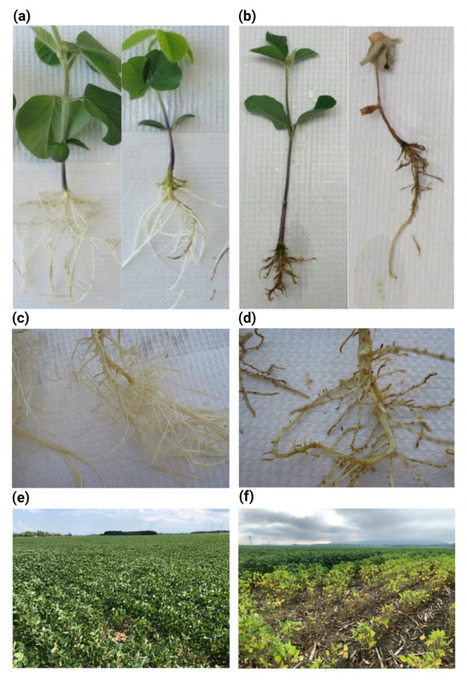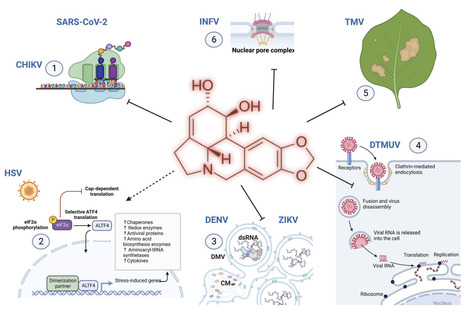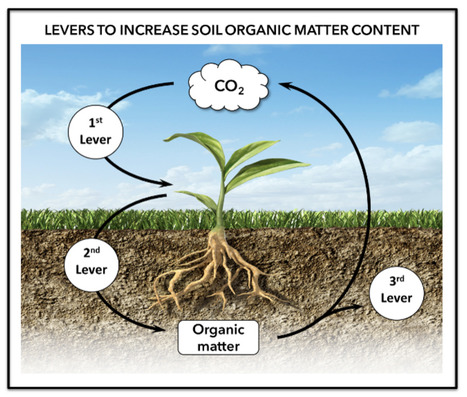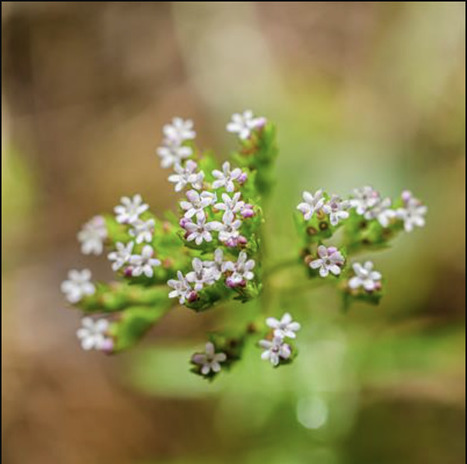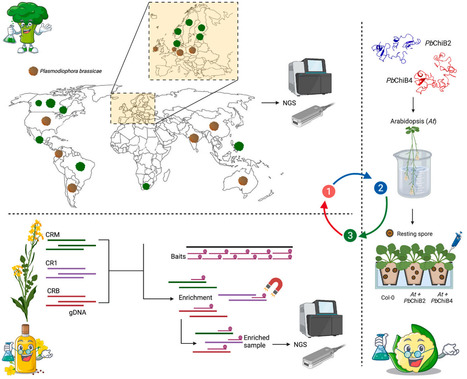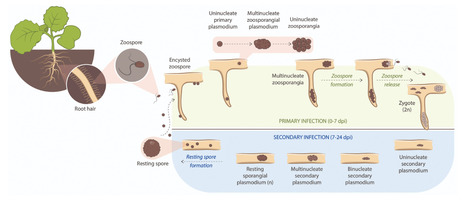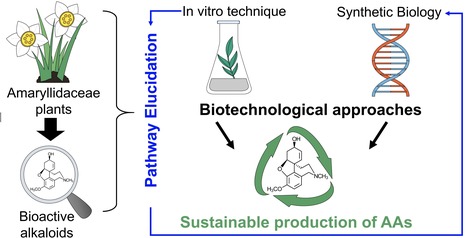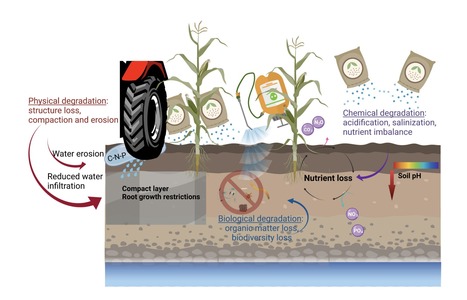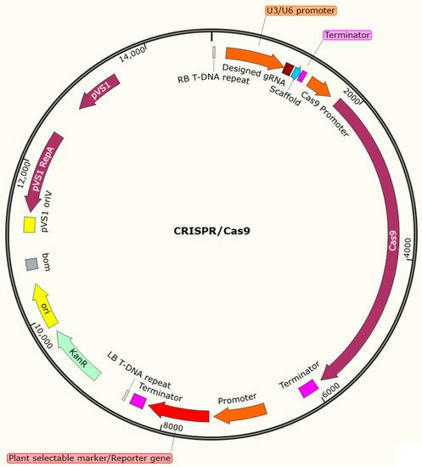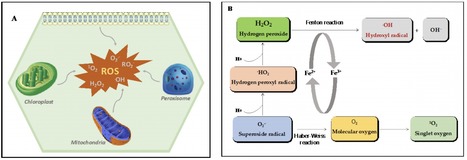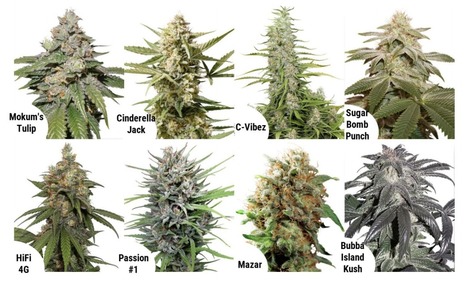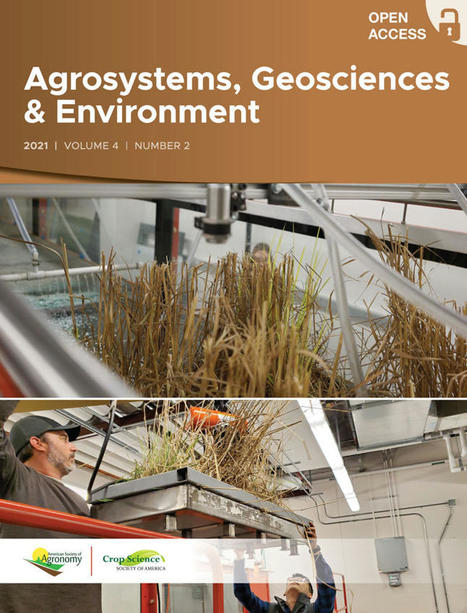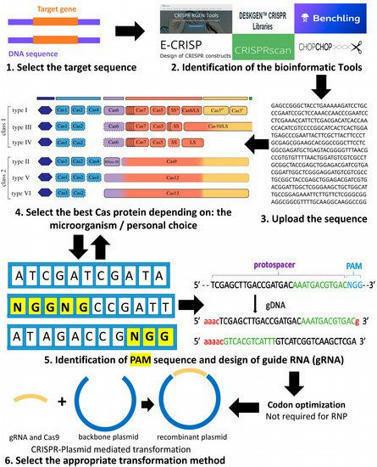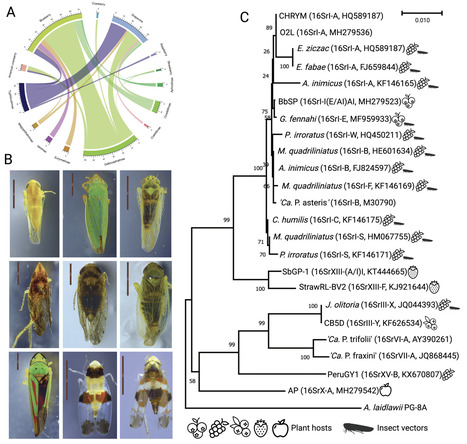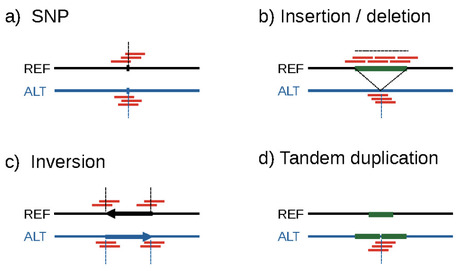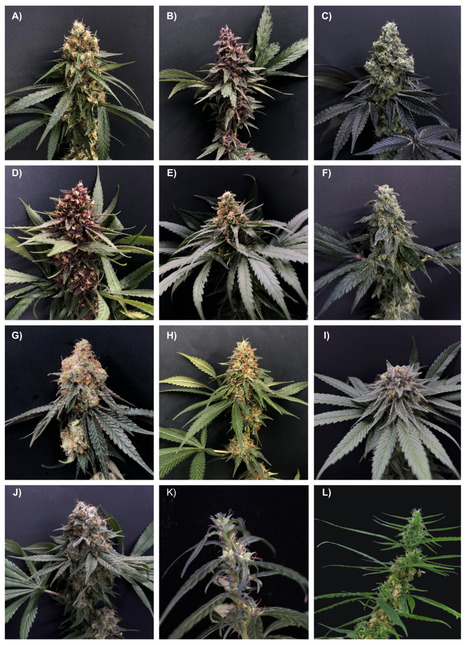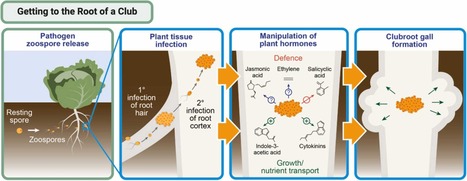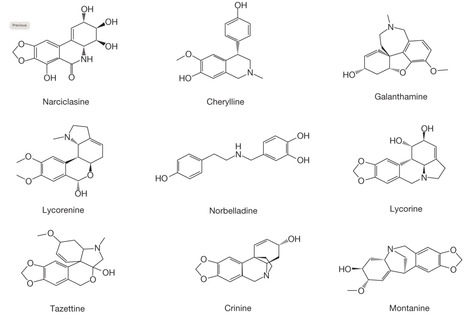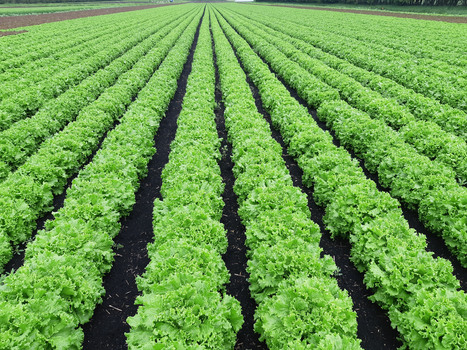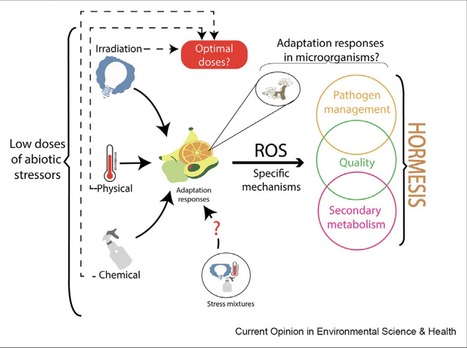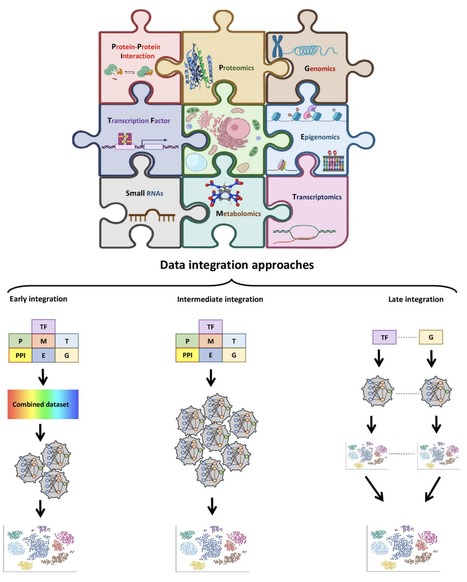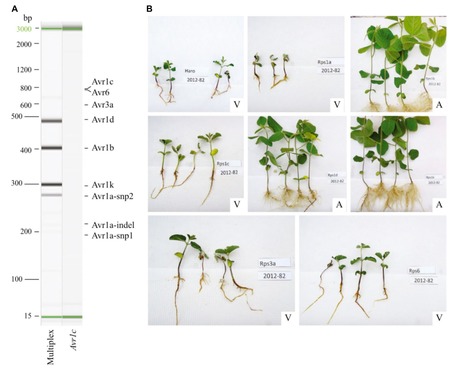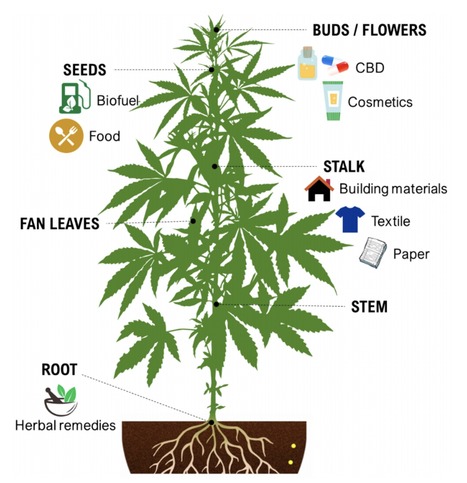 Your new post is loading...
 Your new post is loading...

|
Scooped by
ulcriv
|
Amaryllidaceae alkaloids (AAs) are a unique class of specialized metabolites containing heterocyclic nitrogen bridging that play a distinct role in higher plants. Irrespective of their diverse structures, most AAs are biosynthesized via intramolecular oxidative coupling. The complex organization of biosynthetic pathways is constantly enlightened by new insights owing to the advancement of natural product chemistry, synthetic organic chemistry, biochemistry, systems and synthetic biology tools and applications. These promote novel compound identification, trace-level metabolite quantification, synthesis, and characterization of enzymes engaged in AA catalysis, enabling the recognition of biosynthetic pathways. A complete understanding of the pathway benefits biotechnological applications in the long run. This review emphasizes the structural diversity of the AA specialized metabolites involved in biogenesis although the process is not entirely defined yet. Moreover, this work underscores the pivotal role of synthetic and enantioselective studies in justifying biosynthetic conclusions. Their prospective candidacy as lead constituents for antiviral drug discovery has also been established. However, a complete understanding of the pathway requires further interdisciplinary efforts in which antiviral studies address the structure–activity relationship. This review presents current knowledge on the topic.

|
Scooped by
ulcriv
|
One widely recognized climate change mitigation strategy in agriculture is enhancing soil carbon (C) sequestration – the process of capturing atmospheric carbon dioxide and storing it in the soil. By adopting natural climate solutions (NCS) such as cover crops, reduced tillage, and diverse crop rotations, farmers can increase soil C sequestration and co-benefits such as biodiversity. Canada is increasingly interested in better positioning farmers to adopt NCS via government cost-share programs, ecosystem marketplaces, and outreach and education initiatives. Given the policy and market driven interest in soil C sequestration in agriculture, there is a need to advance the science policy interface, ensuring foundational science, NCS implementation, and approaches to promote NCS are aligned. Herein, the objective is to present insights from multiple disciplines that can help build connections between soil carbon sequestration science and policy relevant to Canada's croplands. The method is a review of literature on soil and pedoclimate science, agricultural NCS adoption, agricultural NCS governance, and science policy interfaces to achieve this objective. From this review, key insights underline that Canadian cropland soils do not have a homogenous history in NCS adoption and production type, nor are all regions influenced by the same contextual factors, have the same potential in C storage or exist within the same agri-environmental conditions. Therefore, it is emphasized herein that policies that aim to enhance soil organic carbon in croplands should consider local context and C sequestration potential. Policies and programs implemented locally to enhance C sequestration across Canada should be complemented by nationally scalable measuring and monitoring to ensure outcomes are accounted for against climate goals. This review aims to contribute to building a common understanding of soil C sequestration in Canada’s croplands and its science policy interface. Efforts to further strengthen the science policy interface for soil C sequestration in Canada’s croplands might include greater integration and utilization of science and data from multiple disciplines, co-design and collaborative opportunities, and establishing on-the-ground test projects to explore innovation in policy and market design.

|
Scooped by
ulcriv
|
As green chemical factories, medicinal plants contain a wide range of bioactive compounds crucial for biomaterial industries. Despite their high economic value, medicinal plants are in the last ring of domestication syndrome and have been neglected for many years by plant breeders. In recent years, plant scientists have tried to compensate for these shortages by developing different strategies, especially faster biotechnology-based methods (BBMs) to conserve and improve these valuable but neglected plants. For the first step, the information and awareness of endangered medicinal plants is very important. Kakkar et al. reviewed all available information related to the nomenclature and classification, endangerment, plant morphology, ploidy, secondary metabolites, drug pharmacokinetics, conservation, and omics-based computational studies in Aconitum genus. The presented information is very valuable in terms of conservation of endangered economically important poisonous mountainous medicinal plant species in this genus.The assessment of the genetic background of valuable medicinal plants is the second step to improve medicinal plants and schedule efficient breeding programs. In this context, the research article by Wei et al. applied the complete chloroplast genome sequencing and phylogenetic study to distinguish three Gaoben-related medicinal plants, including Ligusticum sinense, L. jeholense, and Conioselinum vaginatum, which are similar in morphology and are difficult t

|
Scooped by
ulcriv
|
Clubroot is a devastating disease affecting cruciferous crops worldwide, caused by the obligate parasite Plasmodiophora brassicae. Currently, the use of clubroot resistant cultivars is the best strategy to stop the spreading of the disease and avoid millionaire loses experienced by the industry every year. Unfortunately, after decades of research, clubroot resistance is being overcome by new pathotypes and the mechanisms behind this remain unknown. Here we discuss how we can advance our understanding of the pathogen and the host through genomics. However, this multilayered strategy needs to be concerted to find a stable solution for growers.

|
Scooped by
ulcriv
|
Phytophthora sojae, the agent responsible for stem and root rot, is one of the most damaging plant pathogens of soybean. To establish a compatible-interaction, P. sojae secretes a wide array of effector proteins into the host cell. These effectors have been shown to act either in the apoplastic area or the cytoplasm of the cell to manipulate the host cellular processes in favor of the development of the pathogen. Deciphering effector-plant interactions is important for understanding the role of P. sojae effectors in disease progression and developing approaches to prevent infection. Here, we review the subcellular localization, the host proteins, and the processes associated with P. sojae effectors. We also discuss the emerging topic of effectors in the context of effector-resistance genes interaction, as well as model systems and recent developments in resources and techniques that may provide a better understanding of the soybean-P. sojae interaction.

|
Scooped by
ulcriv
|
Background: Plasmodiophora brassicae is the causal agent of clubroot disease of cru-ciferous plants and one of the biggest threats to the rapeseed (Brassica napus) and brassica vegetable industry worldwide. Disease symptoms: In the advanced stages of clubroot disease wilting, stunting, yel-lowing, and redness are visible in the shoots. However, the typical symptoms of the disease are the presence of club-shaped galls in the roots of susceptible hosts that block the absorption of water and nutrients. Host range: Members of the family Brassicaceae are the primary host of the patho-gen, although some members of the family, such as Bunias orientalis, Coronopus squa-matus, and Raphanus sativus, have been identified as being consistently resistant to P. brassicae isolates with variable virulence profile. Taxonomy: Class: Phytomyxea; Order: Plasmodiophorales; Family: Plasmodiophoraceae; Genus: Plasmodiophora; Species: Plasmodiophora brassicae (Woronin, 1877). Distribution: Clubroot disease is spread worldwide, with reports from all continents except Antarctica. To date, clubroot disease has been reported in more than 80 countries. Pathotyping: Based on its virulence on different hosts, P. brassicae is classified into pathotypes or races. Five main pathotyping systems have been developed to under-stand the relationship between P. brassicae and its hosts. Nowadays, the Canadian clubroot differential is extensively used in Canada and has so far identified 36 differ-ent pathotypes based on the response of a set of 13 hosts. Effectors and resistance: After the identification and characterization of the clubroot pathogen SABATH-type methyltransferase PbBSMT, several other effectors have been characterized. However, no avirulence gene is known, hindering the functional characterization of the five intercellular nucleotide- binding (NB) site leucine- rich- repeat (LRR) receptors (NLRs) clubroot resistance genes validated to date.

|
Scooped by
ulcriv
|
Amaryllidaceae alkaloids (AAs) are plant specialized metabolites with therapeutic properties exclusively produced by the Amaryllidaceae plant family. The two most studied representatives of the family are galanthamine, an acetylcholinesterase inhibitor used as a treatment of Alzheimer’s disease, and lycorine, displaying potent in vitro and in vivo cytotoxic and antiviral properties. Unfortunately, the variable level of AAs’ production in planta restricts most of the pharmaceutical applications. Several biotechnological alternatives, such as in vitro culture or synthetic biology, are being developed to enhance the production and fulfil the increasing demand for these AAs plant-derived drugs. In this review, current biotechnological approaches to produce different types of bioactive AAs are discussed.

|
Scooped by
ulcriv
|
Phytotechnology has traditionally been considered as a tool to remediate contaminated soils. While phytotechnology has been generally defined as the application of science and engineering to study problems and provide solutions involving plants, the practical applications go far beyond restoring contaminated land. This review aims to broaden the way we think about phytotechnologies while highlighting how these living technologies can restore, conserve and regenerate the multiple functions and ecosystem services provided by the soil, particularly in the context of agroecosystems. At first, the main problems of soil degradation in agroecosystems are shortly underlined. Subsequently, the importance of plants and their living roots as engines of restoration are reviewed. This paper demonstrates the importance of root traits and functions for soil restoration. It also demonstrates that plant and root diversity together with perenniality are key component of an efficient soil restoration process. Then, a phytotechnology toolbox which includes three pillars for agroecosystems restoration is presented. The three pillars are agricultural practices and land management (1), rhizosphere engineering (2) and ecological intensification (3). This paper also highlights the importance of developing targeted phytotechnology-based restoration strategies developed from root functions and knowledge of rhizosphere processes. More work is needed to evaluate the potential benefits of incorporating phytotechnology-based restoration strategies in the context of grain or vegetable crop productions as most of the studies for agroecosystem restoration strategies were intended to mimic natural prairies.

|
Scooped by
ulcriv
|
Sequence and expression data obtained by next-generation sequencing (NGS)-based forward genetics methods often allow the identification of candidate causal genes. To provide true experimental evidence of a gene’s function, reverse genetics techniques are highly valuable. Site-directed mutagenesis through transfer DNA (T-DNA) delivery is an efficient reverse screen method in plant functional analysis. Precise modification of targeted crop genome sequences is possible through the stable and/or transient delivery of clustered regularly interspaced short palindromic repeat (CRISPR)/CRISPR-associated protein (CRISPR/Cas) reagents. Currently, CRISPR/Cas9 is the most powerful reverse genetics approach for fast and precise functional analysis of candidate genes/mutations of interest. Rapid and large-scale analyses of CRISPR/Cas-induced mutagenesis is achievable through Agrobacterium rhizogenes-mediated hairy root transformation. The combination of A. rhizogenes hairy root-CRISPR/Cas provides an extraordinary platform for rapid, precise, easy, and cost-effective “in root” functional analysis of genes of interest in legume plants, including soybean. Both hairy root transformation and CRISPR/Cas9 techniques have their own complexities and considerations. Here, we discuss recent advancements in soybean hairy root transformation and CRISPR/Cas9 techniques. We highlight the critical factors required to enhance mutation induction and hairy root transformation, including the new generation of reporter genes, methods of Agrobacterium infection, accurate gRNA design strategies, Cas9 variants, gene regulatory elements of gRNAs and Cas9 nuclease cassettes and their configuration in the final binary vector to study genes involved in root-related traits in soybean.

|
Scooped by
ulcriv
|
Plants are sessile in nature and they perceive and react to environmental stresses such as abiotic and biotic factors. These induce a change in the cellular homeostasis of reactive oxygen species (ROS). ROS are known to react with cellular components, including DNA, lipids, and proteins, and to interfere with hormone signaling via several post-translational modifications (PTMs). Protein carbonylation (PC) is a non-enzymatic and irreversible PTM induced by ROS. The non-enzymatic feature of the carbonylation reaction has slowed the efforts to identify functions regulated by PC in plants. Yet, in prokaryotic and animal cells, studies have shown the relevance of protein carbonylation as a signal transduction mechanism in physiological processes including hydrogen peroxide sensing, cell proliferation and survival, ferroptosis, and antioxidant response. In this review, we provide a detailed update on the most recent findings pertaining to the role of PC and its implications in various physiological processes in plants. By leveraging the progress made in bacteria and animals, we highlight the main challenges in studying the impacts of carbonylation on protein functions in vivo and the knowledge gap in plants. Inspired by the success stories in animal sciences, we then suggest a few approaches that could be undertaken to overcome these challenges in plant research. Overall, this review describes the state of protein carbonylation research in plants and proposes new research avenues on the link between protein carbonylation and plant redox biology.

|
Scooped by
ulcriv
|
Although cannabis is legalized and accepted as an agricultural commodity in many places around the world, a significant lack of public germplasm repositories remains an unresolved problem in the cannabis industry. The acquisition, preservation and evaluation of germplasm including landraces and ancestral populations is key to unleash the full potential of cannabis in the global marketplace. We argue here that accessible germplasm resources are crucial for long-term economic viability, preserving genetic diversity, breeding, innovation, and the long-term sustainability of the crop. We believe that cannabis restrictions require a second look to allow genebanks to play a fuller and more effective role in conservation, sustainable use, and exchange of cannabis genetic resources.

|
Scooped by
ulcriv
|
The intensification of agriculture has resulted in the loss of species diversity in agroecosystems. Crop diversification not only improves ecosystem functions but increases agroecosystem resilience to climate change. Cover crops (CC) are used in the crop rotation to increase plant diversity and provide continuous living roots and soil cover. Previous studies have focused mainly on pure stands of CC and on binary mixtures. In recent years, there has been a growing interest in multispecies mixtures (>2 species). Here, we review reports from the literature to document the effectiveness of fall‐seeded CC mixtures to provide agroecosystem services such as weed suppression, N cycling, soil organic C storage, and crop productivity. We cover both organic and conventional field crop systems in North America and Europe. We found, for both systems, that fall‐seeded CC mixtures increased many agroecosystem services compared with a control without CC; however, they had inconsistent effects in comparison with a pure stand. The capacity of mixtures to enhance a given agroecosystem service was found to be dependent on the species functional group. Legume‐based mixtures increased soil N and C contents along with crop yield, whereas nonlegume mixtures improved N recycling and weed suppression. Differences in the functional groups within CC mixtures could lead to trade‐offs among agroecosystem services. Future research should focus on what drives species‐specific contributions to productivity and other ecosystem services when CC are seeded in mixtures. More long‐term research is needed to provide better insights into the stability of the ecosystem services provided by CC mixtures.

|
Scooped by
ulcriv
|
Microalgae are promising photosynthetic unicellular eukaryotes among the most abundant on the planet and are considered as alternative sustainable resources for various industrial applications. Chlamydomonas is an emerging model for microalgae to be manipulated by multiple biotechnological tools in order to produce high-value bioproducts such as biofuels, bioactive peptides, pigments, nutraceuticals, and medicines. Specifically, Chlamydomonas reinhardtii has become a subject of different genetic-editing techniques adapted to modulate the production of microalgal metabolites. The main nuclear genome-editing tools available today include zinc finger nucleases (ZFNs), transcriptional activator-like effector nucleases (TALENs), and more recently discovered the clustered regularly interspaced short palindromic repeats (CRISPR)-CRISPR associated protein (Cas) nuclease system. The latter, shown to have an interesting editing capacity, has become an essential tool for genome editing. In this review, we highlight the available literature on the methods and the applications of CRISPR-Cas for C. reinhardtii genetic engineering, including recent transformation methods, most used bioinformatic tools, best strategies for the expression of Cas protein and sgRNA, the CRISPR-Cas mediated gene knock-in/knock-out strategies, and finally the literature related to CRISPR expression and modification approaches.
|

|
Scooped by
ulcriv
|
Climate change has facilitated the introduction, establishment, and movement of invasive species in northern regions, enabling the colonization of previously unsuitable areas. While the responses of insects to these changes have been increasingly studied, our understanding of how such alterations impact trophic interactions still requires further research to make reliable predictions about the spread of diseases in a warming world. Phytoplasmas, a group of obligate parasitic unculturable Mollicutes, primarily rely on leafhoppers (Hemiptera: Cicadellidae) for transmission, spread, and survival. Phytoplasmas are associated with over 600 diseases affecting more than 1,000 plant species, including berries, grapevines, and other small fruits. In North America, diseases such as grapevine yellows, blueberry stunt, and strawberry green petal diseases have been linked to phytoplasma strains transmitted by known leafhopper species. However, the number of phytoplasma diseases has significantly increased in North America over the past decade, suggesting the presence of unidentified vectors or an abundance of leafhopper vectors. This short review provides an overview of the current knowledge on leafhoppers as vectors of phytoplasmas to berries, focusing on the last decade’s research in Canada. This paper also explores the potential implications of climate change on this pathosystem, including the anticipated range expansion of leafhopper species, changes in phytoplasma acquisition and transmission, and the risk of new leafhopper-transmitted plant-pathogen introductions through the arrival of new leafhopper species.

|
Scooped by
ulcriv
|
Genome-wide association studies (GWAS) have allowed the discovery of marker–trait associations in crops over recent decades. However, their power is hampered by a number of limitations, with the key one among them being an overreliance on single-nucleotide polymorphisms (SNPs) as molecular markers. Indeed, SNPs represent only one type of genetic variation and are usually derived from alignment to a single genome assembly that may be poorly representative of the population under study. To overcome this, k-mer-based GWAS approaches have recently been developed. k-mer-based GWAS provide a universal way to assess variation due to SNPs, insertions/deletions, and structural variations without having to specifically detect and genotype these variants. In addition, k-mer-based analyses can be used in species that lack a reference genome. However, the use of k-mers for GWAS presents challenges such as data size and complexity, lack of standard tools, and potential detection of false associations. Nevertheless, efforts are being made to overcome these challenges and a general analysis workflow has started to emerge. We identify the priorities for k-mer-based GWAS in years to come, notably in the development of user-friendly programs for their analysis and approaches for linking significant k-mers to sequence variation.

|
Scooped by
ulcriv
|
In the 18th century, Carolus Linnaeus created a formalized system of classification of living organisms based on their anatomic relationships, which we know as taxonomic nomenclature. Historically, the genus Cannabis has been described three ways under this system: Cannabis sativa by C. Linnaeus in 1753, Cannabis indica by J.B. Lamarck in 1785, and Cannabis ruderalis by D.E. Janischewsky in 1924, with these taxonomic classifications having been derived from physical, morphological, chemical, and geographical data. Today, this confusing taxonomy has led to an ongoing debate about whether the genus Cannabis consists of a single species or multiple distinct species or subspecies. Recently, genome sequencing and bioinformatics have provided greater resolution of taxonomic assignments at the species level. As a result, some previously discussed classification frameworks have been brought into question. The aim of this review is to provide a historical context for the confusion surrounding the taxonomy of the genus Cannabis and highlight recent research on genomics-based taxonomical approaches to clarify the question of Cannabis taxonomy. We suggest that the latest evidence shifts away from the previous multiple species framework and points towards the genus Cannabis consisting of a highly diverse monotypic species.

|
Scooped by
ulcriv
|
Plasmodiophora brassicae Wor., the clubroot pathogen, is the perfect example of an “atypical” plant pathogen. This soil-borne protist and obligate biotrophic parasite infects the roots of cruciferous crops, inducing galls or clubs that lead to wilting, loss of productivity, and plant death. Unlike many other agriculturally relevant pathosystems, research into the molecular mechanisms that underlie clubroot disease and Plasmodiophora-host interactions is limited. After release of the first P. brassicae genome sequence and subsequent availability of transcriptomic data, the clubroot research community have implicated the involvement of phytohormones during the clubroot pathogen’s manipulation of host development. Herein we review the main events leading to the formation of root galls and describe how modulation of select phytohormones may be key to modulating development of the plant host to the benefit of the pathogen. Effector-host interactions are at the base of different strategies employed by pathogens to hijack plant cellular processes. This is how we suspect the clubroot pathogen hijacks host plant metabolism and development to induce nutrient-sink roots galls, emphasizing a need to deepen our understanding of this master manipulator.

|
Scooped by
ulcriv
|
RNA viruses are the most common class of pathogens responsible for the emergence of new human diseases, with two to three newly identified viruses annually. The recent 2019 coronavirus disease pandemic (Covid-19) underscores the importance of discovering new and effective antiviral agents. Alkaloids are a class of heterocyclic organic molecules bearing one or more nitrogen atoms and exhibiting a wide variety of structures. Several plant alkaloids are known for their extensive therapeutic properties. The objective of this review is to highlight the antiviral potential of alkaloids from Amaryllidaceae and from other types of plants against several families of RNA viruses, such as Flaviviruses, coronaviruses, Alphaviruses, Alphainfluenzaviruses and also against human immunodeficiency virus type 1 (HIV-1). Alkaloids act against viruses using several strategies and target both viral and cellular proteins. These molecules are bioactive agents that offer attractive prospects in the search for new antiviral drugs.

|
Scooped by
ulcriv
|
Nitrogen (N), a common chemical element in the atmosphere (78% of our atmosphere) yet less common within the Earth’s crust (less than 2%), is a crucial nutrient for life. It is an essential constituent of many cells, such as amino acids, proteins, chlorophyll, and even DNA, and is involved in various processes, such as photosynthesis, energy transfer, growth and reproduction. Up to 90% of the N in surface soils is organic in nature and is contained in soil organic matter (SOM). N cycling is complex, with numerous interacting controlling factors. Scientists around the world have been working for many decades now to understand, model and predict the soil’s capacity to supply N to plants in different ecosystems, whether agricultural, forest, grassland or urban. Plant available nitrogen (PAN) is a pillar of the functioning and productivity of any ecosystem.

|
Scooped by
ulcriv
|
The evolutionary fitness of plants to changing environments has been a continuous effort of stimulatory or adaptive responses to stress-induced hormesis; it is somewhat considered transgenerational. Recently, stress-induced hormesis in produce has recently drawn much attention, and various abiotic stressors have been tested successfully. The beneficial effects of hormesis in harvested crops include delayed senescence, disease resistance and enhanced abundance of secondary metabolites. This review attempts to give an overview of the importance of postharvest hormesis, the possible existence of such phenomenon in various stressors, possible underlying mechanisms involved, and finally provide some perspectives for its future application.

|
Scooped by
ulcriv
|
Sequencing technologies are evolving at a rapid pace, enabling the generation of massive amounts of data in multiple dimensions (e.g., genomics, epigenomics, transcriptomic, metabolomics, proteomics, and single-cell omics) in plants. To provide comprehensive insights into the complexity of plant biological systems, it is important to integrate diferent omics datasets. Although recent advances in computational analytical pipelines have enabled efcient and high-quality exploration and exploitation of single omics data, the integration of multidimensional, heterogenous, and large datasets (i.e., multi-omics) remains a challenge. In this regard, machine learning (ML) ofers promising approaches to integrate large datasets and to recognize fne-grained patterns and relationships. Nevertheless, they require rigorous optimizations to process multi-omicsderived datasets. In this review, we discuss the main concepts of machine learning as well as the key challenges and solutions related to the big data derived from plant system biology. We also provide in-depth insight into the principles of data integration using ML, as well as challenges and opportunities in diferent contexts including multi-omics, single-cell omics, protein function, and protein–protein interaction.

|
Scooped by
ulcriv
|
The SoyaGen project was a collaborative endeavor involving Canadian soybean researchers and breeders from academia and the private sector as well as international collaborators. Its aims were to develop genomics-derived solutions to real-world challenges faced by breeders. Based on the needs expressed by the stakeholders, the research efforts were focused on maximizing realized yield through optimization of maturity and improved disease resistance. The main deliverables related to molecular breeding in soybean will be reviewed here. These include: (1) SNP datasets capturing the genetic diversity within cultivated soybean (both within a worldwide collection of > 1,000 soybean accessions and a subset of 102 short-season accessions (MG0 and earlier) directly relevant to this group); (2) SNP markers for selecting favorable alleles at key maturity genes as well as loci associated with increased resistance to key pathogens and pests (Phytophthora sojae, Heterodera glycines, Sclerotinia sclerotiorum); (3) diagnostic tools to facilitate the identification and mapping of specific pathotypes of P. sojae; and (4) a genomic prediction approach to identify the most promising combinations of parents. As a result of this fruitful collaboration, breeders have gained new tools and approaches to implement molecular, genomics-informed breeding strategies. We believe these tools and approaches are broadly applicable to soybean breeding efforts around the world.

|
Scooped by
ulcriv
|
Background. Silicon (Si) is widely considered a non-essential but beneficial element for higher plants, providing broad protection against various environmental stresses (both biotic and abiotic), particularly in species that can readily absorb the element. Two plasma-membrane proteins are known to coordinate the radial transport of Si (in the form of Si(OH)4) from soil to xylem within roots: the influx channel Lsi1 and the efflux transporter Lsi2. From a structural and mechanistic perspective, much more is known about Lsi1 (a member of the NIP-III subgroup of the Major Intrinsic Proteins) compared to Lsi2 (a putative Si(OH)4/H+ antiporter, with some homology to bacterial anion transporters). Scope. Here, we critically review the current state of understanding regarding the physiological role and molecular characteristics of Lsi2. We demonstrate that the structure–function relationship of Lsi2 is largely uncharted and that the standing transport model requires much better supportive evidence. We also provide (to our knowledge) the most current and extensive phylogenetic analysis of Lsi2 from all fully sequenced higher-plant genomes. We end by suggesting research directions and hypotheses to elucidate the properties of Lsi2. Conclusions. Given that Lsi2 is proposed to mediate xylem Si loading and thus root-to-shoot translocation and biosilicification, it is imperative that the field of Si transport focus its efforts on a better understanding of this important topic. With this review, we aim to stimulate and advance research in the field of Si transport and thus better exploit Si to improve crop resilience and agricultural output.

|
Scooped by
ulcriv
|
For a long time, Cannabis sativa has been used for therapeutic and industrial purposes. Due to its increasing demand in medicine, recreation, and industry, there is a dire need to apply new biotechnological tools to introduce new genotypes with desirable traits and enhanced secondary metabolite production. Micropropagation, conservation, cell suspension culture, hairy root culture, polyploidy manipulation, and Agrobacterium-mediated gene transformation have been studied and used in cannabis. However, some obstacles such as the low rate of transgenic plant regeneration and low efficiency of secondary metabolite production in hairy root culture and cell suspension culture have restricted the application of these approaches in cannabis. In the current review, in vitro culture and genetic engineering methods in cannabis along with other promising techniques such as morphogenic genes, new computational approaches, clustered regularly interspaced short palindromic repeats (CRISPR), CRISPR/Cas9-equipped Agrobacterium-mediated genome editing, and hairy root culture, that can help improve gene transformation and plant regeneration, as well as enhance secondary metabolite production, have been highlighted and discussed.

|
Scooped by
ulcriv
|
Abiotic and biotic stresses induce the formation of reactive oxygen species (ROS), which subsequently causes the excessive accumulation of aldehydes in cells. Stress-derived aldehydes are commonly designated as reactive electrophile species (RES) as a result of the presence of an electrophilic α, β-unsaturated carbonyl group. Aldehyde dehydrogenases (ALDHs) are NAD(P)+-dependent enzymes that metabolize a wide range of endogenous and exogenous aliphatic and aromatic aldehyde molecules by oxidizing them to their corresponding carboxylic acids. The ALDH enzymes are found in nearly all organisms, and plants contain fourteen ALDH protein families. In this review, we performed a critical analysis of the research reports over the last decade on plant ALDHs. Newly discovered roles for these enzymes in metabolism, signaling and development have been highlighted and discussed. We concluded with suggestions for future investigations to exploit the potential of these enzymes in biotechnology and to improve our current knowledge about these enzymes in gene signaling and plant development.
|
 Your new post is loading...
Your new post is loading...
 Your new post is loading...
Your new post is loading...



